When performing a gastric ultrasound, the scan must be performed in the RLD position before declaring the stomach empty
When performing a first trimester ultrasound, the presence of echogenic fluid in the cul-de-sac (regardless of amount) is hemorrhage until proven otherwise
The optic nerve sheath diameter (ONSD) is measured 3 mm behind the globe
Tegaderm can potentially damage the ultrasound lens (rubber)(Check with the manufacturer!)
A-lines are echogenic, horizontal lines arranged at equal intervals below the pleural line
Small bowel loop dilatation > 25 mm in diameter is the most sensitive finding for small bowel obstruction
Static air bronchograms favor the diagnosis of atelectasis on thoracic ultrasound
The presence of blood flow with venous augmentation during a lower extremity DVT scan cannot be used to rule out the presence of a DVT
When scanning a subcutaneous abscess always evaluate the posterior wall of the cavity to ensure there are no deeper tracks
Absence of peristalsis can be seen as a late finding in patients with a small bowel obstruction
Cysts that do not meet sonographic criteria for a simple cyst should get follow up imaging
The yolk sac is the first definitive sonographic finding of an intrauterine pregnancy
The diameter of a pericardial effusion should be measured in diastole
Be cautious of quantitative TTE measurements you obtain that are not supported by your 2D assessment
The presence of a midline ovary is significant int he context of ovarian torsion because it is an abnormal location for the ovary and is a recognized imaging feature suggestive of ovarian torsion
Systolic collapse of the right atrium is a highly sensitive (and often the earliest sign) finding in tamponade physiology
The 60/60 sign (RVOT Doppler acceleration time </= 60 ms and tricuspid regurgitation pressure gradient </= 60 mm Hg) is highly specific but not sensitive for acute pulmonary embolism
An eccentric jet is often associated with moderate or severe regurgitation but the presence of an eccentric jet alone is not a reliable indicator of severity
The Plankton sign refers on thoracic ultrasound to the floating debris in a pleural effusion and suggests that the effusion is likely to be exudative or hemorrhagic in nature
The sensitivity of the FAST exam for detecting hemoperitoneum in pregnant patients (2nd/3rd trimester) is lower than in non pregnant patients
Avoid using the term chronic DVT—instead use chronic post-thrombotic changes
Absence of lung sliding with thoracic ultrasound is suggestive of a pneumothorax but is not definitive for the diagnosis
Ultrasound cannot be used to rule out the diagnosis of an ectopic pregnancy
Thoracic ultrasound can detect as little as 20 ml of pleural fluid with some studies finding ultrasound can detect as little as 3-5 ml of pleural fluid
Cobblestoning on soft tissue ultrasound represents edema and can be seen in numerous conditions and is not diagnostic of cellulitis
Vena contracta width >0.6 cm is seen in severe aortic regurgitation
The whirlpool sign (twisted vascular pedicle) is a highly specific finding for ovarian torsion, but is technically challenging to visualize
Dynamic air bronchograms favor the diagnosis of pneumonia on thoracic ultrasound
The presence of intraperitoneal free fluid between bowel loops increases specificity and may indicate more severe or complicated obstruction
Increasing the number of focal zones will decrease the temporal resolution
The most widely accepted primary criteria for diagnosing appendicitis with ultrasound is visualization of a non-compressible, blind-ending tubular structure in the RLQ with an outer diameter >/= 6 mm
Direct visualization of right heart thrombus in transit is a rare but pathognomonic finding for pulmonary embolism
The power slide sign is seen when power Doppler is used to help identify the lung sliding sign
When evaluating for testicular torsion, it is important to evaluate both arterial and venous waveforms
The water bath technique is a scanning technique used to image superficial structures, including structures in the hand or foot


